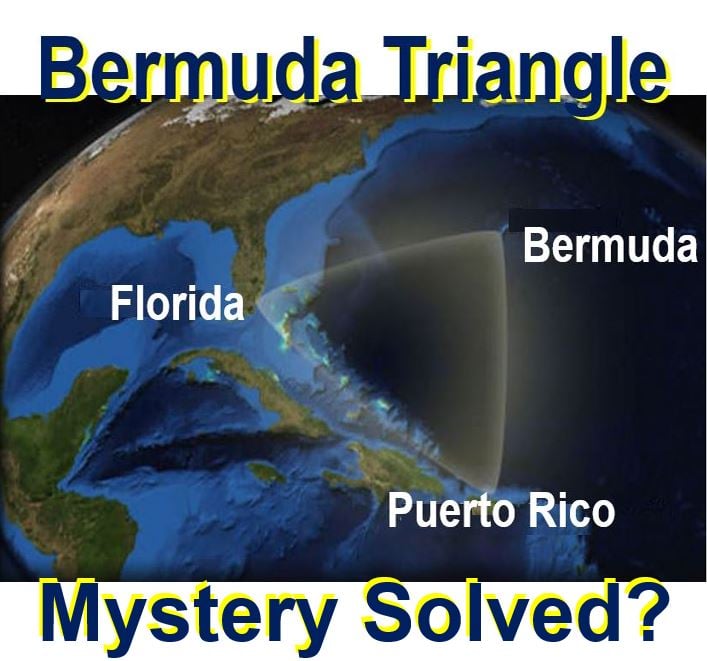The Bermuda triangle appears to have finally been solved by scientists, who say that methane bubble explosions caused by leaking gas from deposits buried deep in the sea floor caused ships and airplanes to disappear. Scientists from the Arctic University of Norway told the Sunday Times that they discovered giant craters on the seabed.
Gigantic chasms about half-a-mile wide and 150 feet deep were discovered on the ocean floor. The scientists believe they may have been caused by oil and gas deposits leaking methane.
The gases, including methane, accumulated within seafloor sediments and then burst through into the surrounding water, they explained.
 According to the National Oceanic and Atmospheric Administration (NOAA): “The Bermuda Triangle is a region in the western part of the North Atlantic Ocean in which ships, planes, and people are alleged to have mysteriously vanished.” (Image: oceanservice.noaa.gov)
According to the National Oceanic and Atmospheric Administration (NOAA): “The Bermuda Triangle is a region in the western part of the North Atlantic Ocean in which ships, planes, and people are alleged to have mysteriously vanished.” (Image: oceanservice.noaa.gov)
A hotspot for shallow methane release
The Arctic University of Norway researchers said:
“Multiple giant craters exist on the sea floor in an area in the west-central Barents sea, and are probably a cause of enormous blowouts of gas.”
“The crater area is likely to represent one of the largest hotspots for shallow marine methane release in the Arctic.”
The Sunday Times report says that recently-developed radar can show images in incredible detail, which clearly show areas of methane seepage across the world.
 Methane gas leaks through the ocean floor and rises in plumes of bubbles across the world. Apparently, the Bermuda Triangle region is a hotspot for such activity. (Image: carbonbrief.org)
Methane gas leaks through the ocean floor and rises in plumes of bubbles across the world. Apparently, the Bermuda Triangle region is a hotspot for such activity. (Image: carbonbrief.org)
The scientists say their discoveries offer the best scientific explanation not only for the disappearance of ships in the notorious Bermuda Triangle, but also sailors’ descriptions of water beginning to bubble and foam developing for no apparent reason.
The researchers will present their findings in full at the annual meeting of the European Geosciences Union in April 2016. They believe these methane bubbles pose a serious threat to the safety of ships.
The Bermuda Triangle
The Bermuda Triangle, also called the Devil’s Triangle, is a mythical area in the Atlantic Ocean roughly bounded by Puerto Rico, a point near Melbourne in Miami, and Bermuda, where several ships and aircraft have mysteriously disappeared.
Many of the disappearances and accidents have occurred in unexplained circumstances. One report describes how pilots of a squadron of US Navy bombers became disoriented while flying over the sea – these airplanes were never found.
Other boats and airplanes have simply vanished from the area in excellent seafaring and flying weather, without even radioing distress messages.
 Over the years, several Bermuda Triangle theories have emerged, including aliens coming down and taking away ships and planes, wormholes into parallel universes, time travel, remnants from the Lost City of Atlantis sucking in ships from our world, giant monsters that can devour large ships, magnetic vortices, electronic fogs, and the spirits of African slaves who were thrown overboard on their voyage to America.
Over the years, several Bermuda Triangle theories have emerged, including aliens coming down and taking away ships and planes, wormholes into parallel universes, time travel, remnants from the Lost City of Atlantis sucking in ships from our world, giant monsters that can devour large ships, magnetic vortices, electronic fogs, and the spirits of African slaves who were thrown overboard on their voyage to America.
For the past 165 years, several theories, some fanciful, have been proposed regarding the Bermuda Triangle. None of them have come even close to convincing scientists, that is, until this latest study.
Since mysterious reports started in 1851, an estimated 8,127 people have been lost in the Bermuda Triangle.
Misleading compass readings in the area are common, apparently caused by magnetic anomalies in the bedrock. The deposits of frozen methane gas are capable of seeping through and exploding in violent outburst called methane blowouts. These blowouts could easily sink a large vessel.
The Bermuda Triangle waters are prone to vortices (waterspouts) that suck up the seawater into the clouds. These waterspouts can create very strong winds – more than 120 mph (190 k/ph) – during the summer months when the air is humid and the waters off Florida’s coast are warm. Experts say the Triangle has about 500 waterspouts annually.
Video – Bermuda Triangle mystery
